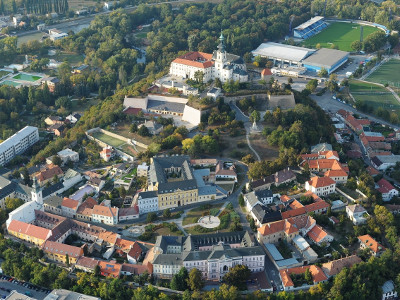Excursions
All excursions must be paid for individually – it is possible to reserve your place on an excursion up until 30/06/2019. If you sign up for an excursion later, we will not be able to guarantee a free place.
Half-day excursions
City and castle of Nitra (on foot)
(8 EUR, 13/07/2019)
Nitra is the oldest city in Slovakia, which chronicles mention as early as the 9th century. The first written mention came from the year 828, when Nitra was an episcopate of the Great Moravian Empire. Nitra is a city of extraordinary historical importance. The beginnings of its settlement are found in prehistory, as proven by archaeological digs in the city limits. Thirty thousand years ago, it was already a densely inhabited area. The area of the modern city of Nitra was an important location for the Celts (several centuries before Christ), later by Germanic tribes, and finally by Slavs. It was the seat of the first known rulers of the modern region of Slovakia – the Germanic tribe of the Quadi (about 396 AD) and from the 8th century until 1108, the seat of the Principality of Nitra.
The most famous relic from history, which also dominates the city's skyline, is an 11th century castle which was rebuilt in the 15th century and was still being renovated in the Baroque era. The castle was built on the site of a Slavic settlement from the 9th century. It is a national cultural heritage site. Today it is the headquarters of the archaeological department of SAV (Slovak Academy of Sciences) and of a bishop. Only the cathedral and the diocesan museum can be visited.
Topoľčianky
(20 EUR, 18/07/2019)
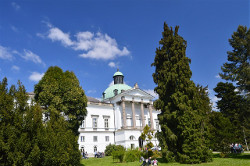
Source: Wikimedia Commons
Topoľčianky is not a very big municipality, but it has many worthwhile attractions. The first written mention of the village is from the year 1293. By the 6th-7th century, Slavs had settled the area. The excursion will have a diverse program, and will try to see everything worth seeing:
- Winery (with wine tasting): the Topoľčianky vineyard produces 5 million litres of wine annually, making it one of the largest wineries in Slovakia.
- A castle from the 15th century: purchased in the year 1890 by the Habsburg family, who possessed it until the collapse of the monarchy. Joseph Augustus Habsburg came to admire the place greatly, so he improved the fortress's equipment, expanded the park, founded the stables and horse breeding facilities and the hunters' castle. After the collapse of monarchy, the castle was purchased by the government of Czechoslovakia and became the summer residence of Czechoslovak presidents. President Tomáš Garrigue Masaryk regularly spent time there. The castle is a national cultural heritage site.
Mlyňany Arboretum
(15 EUR, 15/07/2019)
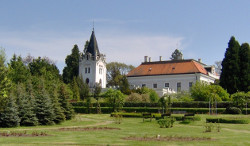
Source: Wikimedia Commons
The Slovak Academy of Sciences' Mlyňany Arboretum (a botanical garden presenting a variety of tree species) is a protected area in the municipalities of Tesárske Mlyňany and Vieska nad Žitavou (Zlaté Moravce District), covering 67 hectares. It acquired its protected status in 1951 and is today used for scientific research by the Slovak Academy of Sciences.
Its founder, Dr Štefan Ambrózy-Migazzi, from Hungary, had been fascinated by botany since childhood. Together with his wife, from Zlaté Moravce, Antónia, he built a castle near Vieska nad Žitavou, surrounded by trees. It was here that he first tried planting foreign species of trees.
The arboretum is now Slovakia's most significant dendrological institution. Its collection includes over 2,300 species from the Mediterranean, the Americas, Africa and Asia.
Full-day excursions
Bratislava
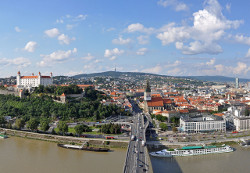
Source: Wikimedia Commons
(30 EUR, 16/07/2019)
Places to be visited: Devín castle ruins, Bratislava castle, old city, and more…
Bratislava is the capital and the largest city in Slovakia (more than 425 thousand inhabitants). The head of state, the government, the parliament, and various offices and ministries are headquartered there, as well as several universities, theaters, museums, and other cultural and scientific institutions. Bratislava is situated on both sides of the river Danube, at the foot of the Lesser Carpathian mountains. The city is near the Czech Republic, Austria, and Hungary. It is the only capital city in the world that shares borders with two countries (Hungary and Austria).
Banská Štiavnica
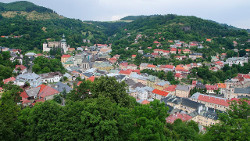
Source: Wikimedia Commons
(30 EUR, 16/07/2019)
Banská Štiavnica is a historic city in central Slovakia, with a very multi-cultural past. It is known for mining of metals (mainly silver), and for its important traditions of mining law, administration, and academics. We will experience a trip into an underground mine at an open-air mining museum; everyone will be equipped witha helmet, lamp, and coat. After lunch, in a guest house we will look at the Old Castle, visit an exposition on minerals, and a shop selling works of Slovak artists. We will end our excursino in the Divná pani tea house. The city is listed as a UNESCO cultural heritage site.




